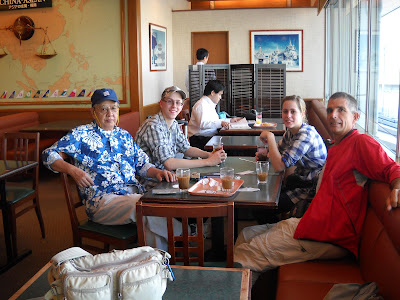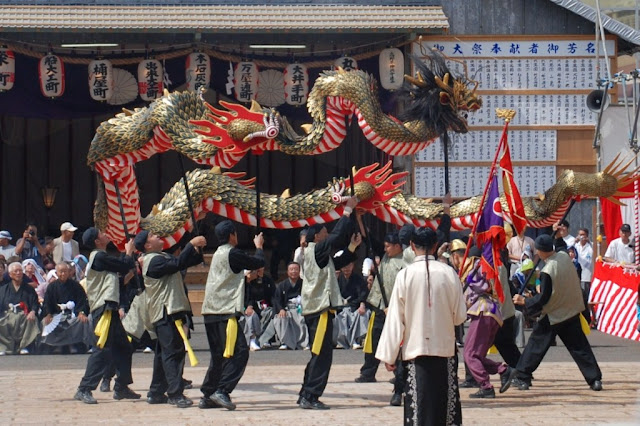A day later we sailed back to
Nagasaki to the small yacht harbor at the Dejima Wharf, right in the center of
the city. All around us people were setting up stalls and stages for what was
going to be one of Japan’s major tourist attractions: The yearly O’ Kunchi
Matsuri.
On the 6th we jumped in a rented car to drive to Fukuoka airport and back, but before that we had a small problem to deal with: we were running out of cooking gas.
Alishan has 2 aluminium gas tanks that were bought, tested and oficially certified in Japan. However, in Fukue we could not get a refill, because aluminum tanks had caused problems in the past and the local gas dealer would only handle steel ones. In Nagasaki there was no gas filling station nearby that neither we, nor our friends knew of, so the easiest thing to do was load the empty tank in the car and drive to the gas company near Fukuoka, where it came from. Now picture this: 2 foreigners, one sporting her favorite scarf: an Arabian headdress, the other looking slauchy like a proper yachty, driving a rental car with a gas tank in the booth, on the highways across Kyushu to a major airport that had extra tight security because of November’s APEC meeting… And nobody noticed.
Welcome to Japan Edwin and Melissa! Here at the airport with Jaap, the could-be terrorist and our faithful Papa-rin
Every year on Oct 7, 8 and 9 neighborhood teams gather around wooden vessels, replicas of the foreign ships that used to frequent the harbor when Nagasaki was the only international port in Japan. These beautifully decorated ships are paraded through the center of town. The children onboard play drums and gongs, men clad in cotton kimono do the pushing and pulling and the women walk behind, dressed in their finest kimonos of brocade and silk. On various locations they stop and perform. Boys show their skills with a throw net, girls throw each other in acrobatic dance.
The men race their ship back, forth and around, while the children inside beat their drums and gongs, and others yell commands. The pace becomes faster at each performance. Spectaters cheer and applaude and the atmosphere is laden with excitement.
Other teams carry heavy portable shrines on poles, XXX again turning around and around. Just watching it would make you dizzy.
A popular group is the team of dragondancers in their elaborate Chinese style costumes. The dragon, just as at Chinese New Year, chases a golden ball, XXX by fire crackers.
The dragon team wears Chinese costumes.
And makes the most noise.
Waiting in between perfomances
The children didn’t seem to be the least bit bothered
by all the tossing and turning. They must have practiced for months!
Musicians and dancers perform in front of shops and businesses to express gratitude for their (financial) support.
On Oct 9th the festival ends with a parade, when floats and shrines return to their resting place.
Alishan, conveniently moored in the middle of this spectacle, became a popular place for friends to take a rest.
The Sawamura clan, who used to live downtown and whith whom we stayed during this festival 21 years ago. Here Mum with some of her12 kids and I don’t know how many grandchildren.
Nobuko Kakoh took some time off from her busy job. (see later) She and our friend and hairdresser Michiyo came over from Fukuoka for the festivities and us. Here comparing photos in front of the Spectacle Bridge.
Alishan by night at Dejima Wharf































No comments:
Post a Comment